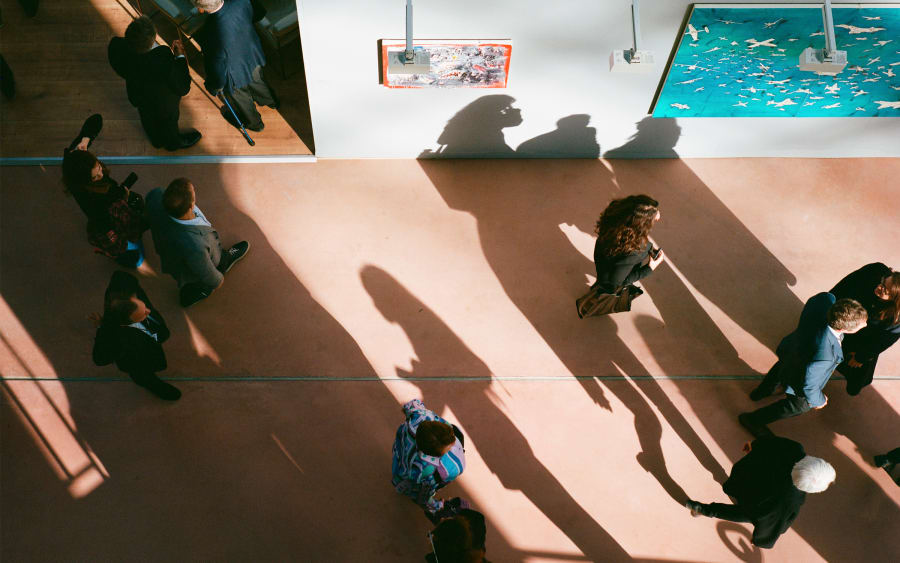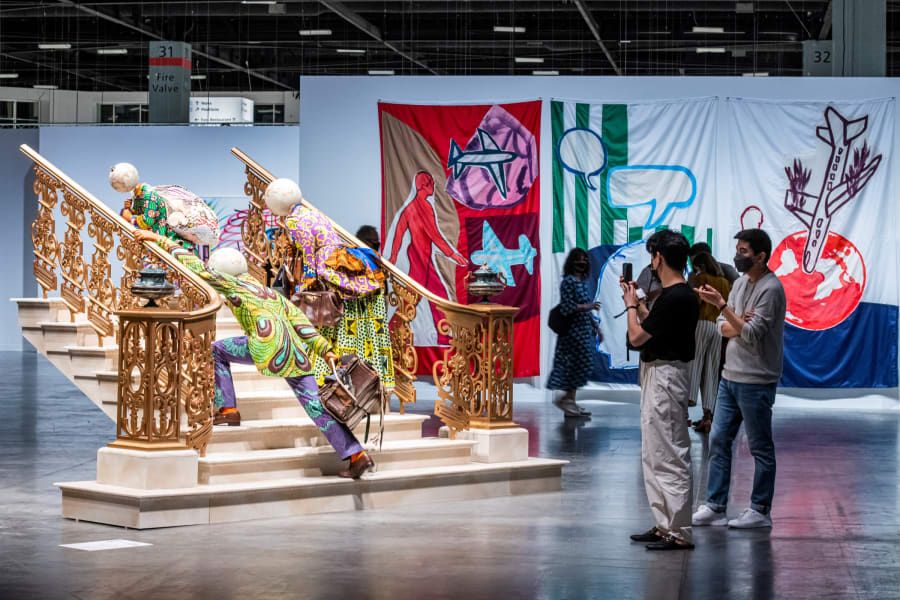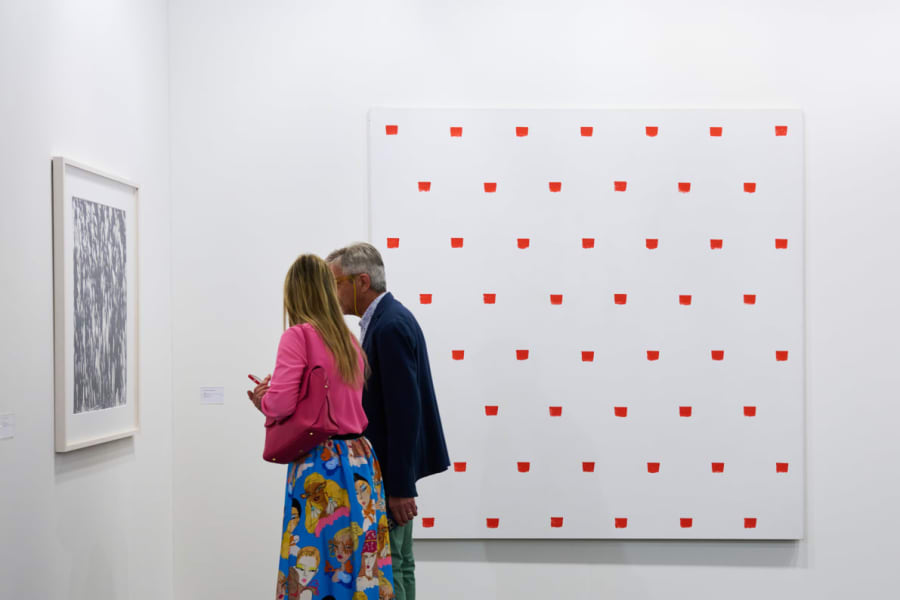In pop culture, few things are as successful as a quartet. ABBA, The Beatles, The Golden Girls, Queen, the Fantastic Four… one could go on and on.
The same could be said about Art Basel’s four shows, each led by a different director. Maike Cruse has headed Art Basel’s flagship fair in Basel since 2023; Clément Delépine has led Art Basel Paris since its inception in 2022; in December 2024, Bridget Finn wrapped up her first Art Basel Miami Beach as sole director; and Angelle Siyang-Le has helmed Art Basel Hong Kong since 2023. Overseeing this team is Vincenzo de Bellis, the Director of Fairs and Exhibition Platforms for the Art Basel brand.
This rather recent structure – which was fully implemented in 2023, when Finn was hired – reflects an art world that has become more networked and global than ever, but at the same time consists of regional scenes and markets with unique players, infrastructures, and idiosyncrasies. Difference is what makes the overall art world dynamic, and it deserves to be developed and celebrated. So how do Art Basel’s directors do just that – alongside their many other responsibilities? How do they define the needs, messages, and potentials of their respective shows, and nurture geographical difference?
An intimate knowledge of – and love for – each show’s cultural ecosystem is central to the job, according to de Bellis. ‘The show directors represent the flavor of each place,’ he says. ‘They’re under a global umbrella, but each is an expert in their region.’
‘Art Basel Paris is not a museum, but it has an institutional responsibility toward its clients, its audience, and its host city,’ says Clément Delépine. Art Basel’s show in the French capital focusses not only on establishing a commercial node in a historically developed art scene, but also on expanding contemporary art’s canon and ‘taking the temperature’ of a specific time and place. With 195 galleries (compared to Basel’s 285 or even Hong Kong’s 242), the Paris fair is Art Basel’s smallest, which demands a certain precision in messaging and a clear profile.
For Delépine, that has meant a strong commitment to the French art scene (more than a third of the fair’s exhibitors operate spaces in France), building strong bridges with the city’s dynamic creative industries, as demonstrated by projects with Miu Miu and the rapper Jemeel, among others, and celebrating Parisian heritage (the Grand Palais, where the fair takes place, is without doubt one of the city’s most iconic buildings). ‘The institutional tissue in Paris is very dense, but as an event we’re now anchored within the Parisian cultural landscape,’ he adds.
Maike Cruse returned to Art Basel as a director after serving as the flagship fair’s communications director from 2008 to 2011. She was impressed to see how global the company had become in the interim. ‘Back then, we were all in Basel, speaking Swiss German, and working on two fairs. Now we speak English, and the team is from all around the world.’ Still, for her first show in Basel in June 2024, her program had a specific, local goal: ‘I wanted to cooperate much more with the city of Basel, because it is a unique place for an art fair due to its size,’ she explains. The density of world-class museums and other institutions is indeed remarkable for a city of under 200,000 inhabitants. To this end, Cruse activated public spaces, moving the Parcours sector to Clarastrasse (a retail-based street near the fair), and created a dynamic performance series in a nearby hotel. This interplay with the city will only deepen, as will efforts to cater to younger collectors. ‘At the moment, a large number of collectors coming to our shows are first time visitors from a younger generation, so we are working hard on a generational shift.’
Bridget Finn, who previously ran both commercial and nonprofit art spaces, sees her role as ‘creating an atmosphere, and thinking about the hospitality aspect and user experience of our clients, from the galleries, to VIPS, and our partners,’ she says. Beyond this, Art Basel Miami Beach is often where the company tests out the new. ‘As the fair operating in the world’s largest art market, Art Basel Miami Beach leads the charge in thinking through new potentials. We launched the new Art Basel app in advance of last year’s show, through our partnership with Microsoft,’ she notes, naming one example. ‘There’s such an interest in tech and the digital space in both North America and South Florida. Art Basel Miami Beach has been evolving for years as a cutting-edge beacon of what can be accomplished on an art-fair platform.’
Angelle Siyang-Le’s vision for Art Basel Hong Kong diverges from the others, in part due to geography. ‘We represent a region that is very different to the locations of our shows in Paris, Basel, and Miami Beach,’ she explains. ‘The Hong Kong show represents not only the city, but also the Asia-Pacific region,’ she explains. In the past few years, the fair has worked on making the many histories and contexts of Asian art more visible and legible to the Western art world, as well as acting as a regional art incubator. We are now able to present a very high-quality artistic program through various galleries and institutions. We act as a bridge, by both bringing international artists to the region and sharing our knowledge with the rest of the world,’ she says.
The directors agree that even if ‘their’ fair takes place just once a year, the job is year-round. Each iteration concludes with a deep debrief, so strategizing the next edition starts the day the previous one ends: ‘You need the learnings from the on-site show to catapult you toward what’s to come,’ says Finn. Throughout the year, the directors regularly meet online to align on overall strategy, or discuss best practices. They also regularly share thoughts in a group chat: ‘We interact with many colleagues on a daily basis, but we don’t have regular people we are speaking with that understand precisely what we’re going through,’ says Delépine. ‘I think we’re all very big fans of each other,’ adds Finn. ‘The relationship between the four of us is incredibly valuable, because there are three other people who have had their version of whatever you’re experiencing. It’s a gift,’ she adds.
The job isn’t always what it might seem to be from the outside: ‘It’s a lot less about schmoozing than people might think,’ says Delépine. Cruse points out that she’s surprisingly hands-on: Artists developing special projects, for example, receive direct calls from her. Having worked with Art Basel in various capacities for many years, starting out as a member of Art Basel’s gallery relations team, Siyang-Le grew into her directorship from within, and explains that there’s little hierarchy within the organization. Finn says people are consistently surprised by how accessible she is. ‘When I tell gallerists that they can call me anytime on WhatsApp,’ says Finn, ‘I really mean it.’
For all four directors and de Bellis, things can get hectic as showtime approaches: ‘We can’t achieve everything at the same time, but we prioritize,’ says Siyang-Le. ‘That’s the greatest challenge, but it’s also just fun.’ During a show, the directors are often on the fair floor hours before opening time, troubleshooting and watching gallerists make last-minute changes; later in the day they might speak to the press and hit as many events – museum openings, receptions, gallery dinners – as they can. And they make sure to speak to every single exhibitor: ‘In our on-site office, there is a giant floor plan with markers,’ says de Bellis. ‘We tick off all the galleries we’ve spoken to or visited. Both the fair director and I speak with all of them by the end of the show. The other directors add on. That’s something we learned from our predecessors.’
Overseeing the directorial quartet, de Bellis is a bridge-builder with a keen eye on future potentials. The executive, who until 2023 was Curator of Visual Arts and Associate Director of Programs at the Walker Art Center in Minneapolis, is also in charge of strategizing new initiatives. Innovation is, after all, part of Art Basel’s DNA. Each fair was once an idea tapping into an art world moment or location, and each has created, and then anchored, enduring ecosystems around contemporary art and other creative industries.
What started in 1970 as a single ship has now become a fleet. Art Basel’s directors act as a tight team, interacting with the world’s top galleries, collectors, and thinkers. And what drives them is also what they share with the broader Art Basel team: a commitment to excellence, precision, and innovation. ‘Concerning the team, the galleries, and all the various functions, what strikes me again and again is the level of accuracy and thought that goes into every single detail,’ says Cruse. ‘Everyone involved is so incredibly dedicated. This is what makes Art Basel, and working for Art Basel, really special.’
Kimberly Bradley is a writer, editor, and educator based in Berlin. She is a commissioning editor at Art Basel Stories and the curator of Art Basel Conversations in Basel and Miami Beach.
Caption for top image, from left to right: Clément Delépine, Maike Cruse, Angelle Siyang-Le, Bridget Finn, and Vincenzo de Bellis. Photography by Noé Cotter for Art Basel.
Published on January 15, 2025.


